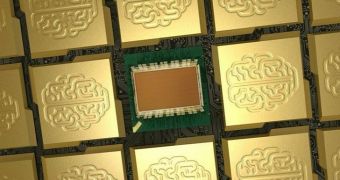No matter how many robot apocalypse movies will be released over the years, there is no chance for any developed country to forbid research of artificial intelligence. Not unless something really terrible happens.
Even so, though, until not long ago AIs were still a pipedream, something that you could only find in books, films, or cartoons. Sure, there were (and still are) a whole bunch of robots and other sorts of automatons in the world, but their ability to perform any sort of sophisticated movement or adopt a certain behavior is limited at best.
Indeed, many of them have experienced rather embarrassing failures when it comes to walking, not to mention anything else.
All this time, however, specialists from the field of microprocessors have been hard at work, and now their efforts are paying off, because a chip that works precisely like the human brain has been created.
Meet TrueNorth
I actually covered this chip’s introduction a few days ago, when researchers from IBM, Cornell Tech, and some collaborators revealed it.
Based on the human brain (it is called a neurosynaptic chip), it mimics the cerebral cortex, specifically the right side of the brain, which processes sights, smells, and other information from the environment.
In other words, the engineers were able to replicate the part of our brains that is responsible for our ability to learn how to respond to situations and all sorts of stimuli.
TrueNorth is, in essence, the key to giving computers and robots the ability to learn and respond to things, just like children.
As if that wasn’t enough, TrueNorth is fully programmable. One million programmable “neurons” are connected through 256 million programmable synapses, making for 4,096 cores and 5.4 billion transistors.
Essentially, it’s a supercomputer on a chip that works on the energy provided by a tiny, hearing-aid battery. You know, one of those little things, no unlike the round “pills” that keep your wrist watch working.
The future begins now, and it’s turned upside down
“The future begins today” is a phrase that has been used and overused to the point that it has lost its allure. Still, I think it fits this situation. It’s not every day that someone makes a small chip that turns one of the biggest elements of science fiction into reality.
But why do I say our progress is twisted? Mostly because, in a large part of Sci Fi, self-determined, sentient robots come after a bunch of other things.
You know, like free energy, true holograms, telepathically-controlled machinery. Honestly, even antigravity engines and/or repulsorifts have been showing up as part of advanced civilizations before the in-universe development of true AI and chips capable of matching or surpassing the human brain in performance.
Then again, there has been a lot of fuss around the Transformers films. But those particular robots supposedly use quantum computers, not whatever TrueNorth is.
That’s another thing: a no small number of people thought that quantum chips would have to be developed before any attempt at a brain-like processor could yield decent results. So much for that assumption I suppose.
Which brings us to the question I’ve been dancing around: is CPU technology about to surpass the human brain? After all, even if a single TrueNorth can’t outdo our trusty grey matter, it wouldn’t be hard to combine two or more of them.
For now, I suppose the answer is no, if only because there is no software and associated hardware that can properly take advantage of everything TrueNorth can do. Still, even if we get a decade or two where this chip only enables smarter smartphones and self-driving cars, I can’t help but think of what will come after.
The TrueNorth works like our brains do, which means that robots and computers based on it will think like us as well. And they will learn through experience and observation.
I just hope the machines in question won’t witness too much bullying, human arrogance, and self-centeredness too early in their “learning” stages.

 14 DAY TRIAL //
14 DAY TRIAL //